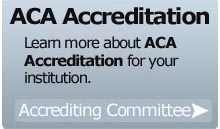
The American Communication Association (ACA) was founded in 1993 for the purposes of fostering scholarship in all areas of human communication behavior, promoting and improving excellence in the pedagogy of communication, providing a voice in communication law and policy, and providing evaluation and certification services for academic programs in communication study. One aspect of our mission is to recognize communication programs that meet or exceed ACA’s expectations on 15 standards of program excellence. ACA accredits certificate, 2-year, 4-year undergraduate, and graduate programs in communication in the U.S. and around the world. The common denominator is that each of these programs focuses on one or more aspects of the human communication experience including, but not limited to: interpersonal, organizational, mass, computer-mediated, advertising, public relations, and international communication.
How does ACA differ from other accrediting bodies? Our organization recognizes that a “one size fits all” approach is counter to the idea that there are multiple paths to excellence. ACA’s service reviews programs based on our 15 standards of excellence – within the context of the academic and social cultures the program represents. (For instance, 2-year programs in one region are compared to similar types of programs at that institution and in that region, not to 4-year programs based in another area.) The standards are firm. How they are applied is flexible, and based on a realistic assessment of the environment in which a communication program resides.
Program accreditation is a voluntary process initiated by the institution seeking accreditation. The material provided here offers specific information on the criteria and procedures adopted by the ACA Board of Directors for the accreditation of such programs.
The Council on Postsecondary Accreditation (COPA) describes accreditation in the following manner:
While accreditation is basically a private, voluntary process, accrediting decisions are used as consideration in many formal actions--by government funding agencies, scholarship commissions, foundations, employers, counselors and potential students. Accrediting bodies, have, therefore, come to be viewed as quasi-public entities with certain responsibilities to the many groups which interact with the educational community.
The accrediting process begins with an institutional or programmatic self-study examining goals, activities, problems, and achievements. The resulting report is the basis for an on-site evaluation by a team of professional peers. The [accrediting organization] reviews the self-study documents and the team reports as the basis for action on accredited status.
The unit's self-study should be futuristic and propose a clear plan for the future of the unit. The faculty should be actively involved in the development of the self-study.
The American Communication Association (ACA) Accrediting Committee has examined the accreditation documents from a variety of respected and prestigious organizations in the construction of our procedures. Among those organizations are the American Speech and Hearing Association (ASHA), the National Association of Schools of Theatre (NAST), the National Association of Schools of Music (NASM), the Southern Association of Schools and Colleges (SACS), and the Accrediting Council on Education in Journalism and Mass Communications (ACEJMC). The ACA provides accreditation to Certificate Programs, Associates Degree Programs, Diploma Programs, and Baccalaureate Programs, and Graduate Programs. . The following criteria and procedures aspire to the same high goals and standards of these organizations.
For more information on ACA Program Accreditation, email : ACA Accreditation





